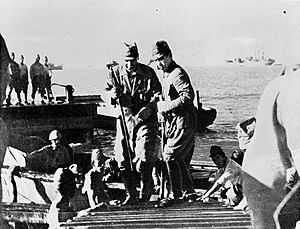Masaharu Homma facts for kids
Quick facts for kids
Masaharu Homma
|
|
|---|---|
|
本間 雅晴
|
|

Homma during the Japanese occupation of the Philippines
|
|
| Governor-General of the Philippines | |
| In office January 3, 1942 – June 8, 1942 |
|
| Preceded by | Newly established |
| Succeeded by | Shizuichi Tanaka |
|
|
| In office January 3, 1942 – January 23, 1942 |
|
| Preceded by | Newly established |
| Succeeded by | Jorge B. Vargas |
| Personal details | |
| Born | November 27, 1887 Sado, Niigata Prefecture, Empire of Japan |
| Died | April 3, 1946 (aged 58) Los Baños, Laguna, Commonwealth of the Philippines |
| Cause of death | Execution by firing squad |
| Nickname | "The Poet General" |
| Military service | |
| Allegiance | |
| Branch/service | |
| Years of service | 1907–1943 |
| Rank | |
| Commands |
|
Masaharu Homma (本間 雅晴, Honma Masaharu, November 27, 1887 – April 3, 1946) was a Japanese army general during World War II. He led the Japanese 14th Army when they invaded the Philippines. Homma was later found guilty of war crimes related to the actions of his soldiers. He was executed on April 3, 1946.
Contents
Early Life and Military Career
Homma was born on Sado Island in Japan. He joined the Imperial Japanese Army Academy in 1907. Later, he also attended the Army Staff College.
Time in the United Kingdom
Homma spent eight years in the United Kingdom as a military attaché. This means he was a military expert working at an embassy. He learned English well and understood Western ways. In 1917, he worked with a British army unit. In 1918, he served with British forces in France during World War I. He even received a British medal called the Military Cross.
From 1930 to 1932, Homma returned to the UK as a military attaché. His English skills were very helpful. He also joined the Japanese team at the Geneva Disarmament Conference in 1932. This was a meeting where countries discussed reducing their weapons.
Leadership Roles in Asia
After his time in the UK, Homma held various command roles. In 1937, he became an aide to Prince Chichibu, the Emperor's brother. They traveled to Europe, attending the coronation of King George VI in Britain. They also visited Germany and met Adolf Hitler.
Homma was promoted to lieutenant general in July 1938. When the Second Sino-Japanese War began, he commanded the IJA 27th Division in China. He led talks with the British during a blockade in Tientsin. He was later moved to command the Taiwan Army District.
The Philippines Campaign
When the Pacific War started, Homma was put in charge of the IJA 14th Army. His mission was to invade the Philippines. He told his soldiers to treat Filipinos kindly and respect their culture. He even made his troops clean up before entering Manila. He wanted them to look disciplined and not cause trouble.
Challenges During the Invasion
Homma's gentle approach upset his boss, General Count Hisaichi Terauchi. Terauchi sent bad reports about Homma to Japan. Also, some of Homma's own officers secretly worked against him. They gave orders that went against Homma's policies. For example, they tried to execute a Filipino leader, but Homma stopped it in time.
Homma didn't expect Filipino and American forces to retreat to the Bataan Peninsula. This slowed down the Japanese plan. When he realized his mistake, his best soldiers had been replaced. This made his attack force weaker. He tried to outsmart the American forces instead of attacking directly. This made his superiors unhappy. They thought he was too soft because he tried to save his soldiers' lives.

The Bataan Death March
The Japanese leaders in Tokyo were worried about the slow progress in Luzon. They ordered Homma to attack again. The Battle of Bataan began in January 1942. After the Japanese won in April, many Allied prisoners of war were forced to march about 60 miles (100 km). This event became known as the Bataan Death March. Many prisoners died during this march due to harsh treatment and abuse from some Japanese soldiers.
Despite winning the battle, Homma's relationship with his superiors got worse. He was removed from command shortly after the Battle of Corregidor. He was forced to retire from the military in August 1943. Homma lived quietly in Japan until the war ended.
Trial and Execution
After World War II, Homma was arrested. He was put on trial for war crimes related to the actions of his troops, especially during the Bataan Death March. He was found guilty and executed by firing squad on April 3, 1946.
See also
 In Spanish: Homma Masaharu para niños
In Spanish: Homma Masaharu para niños


